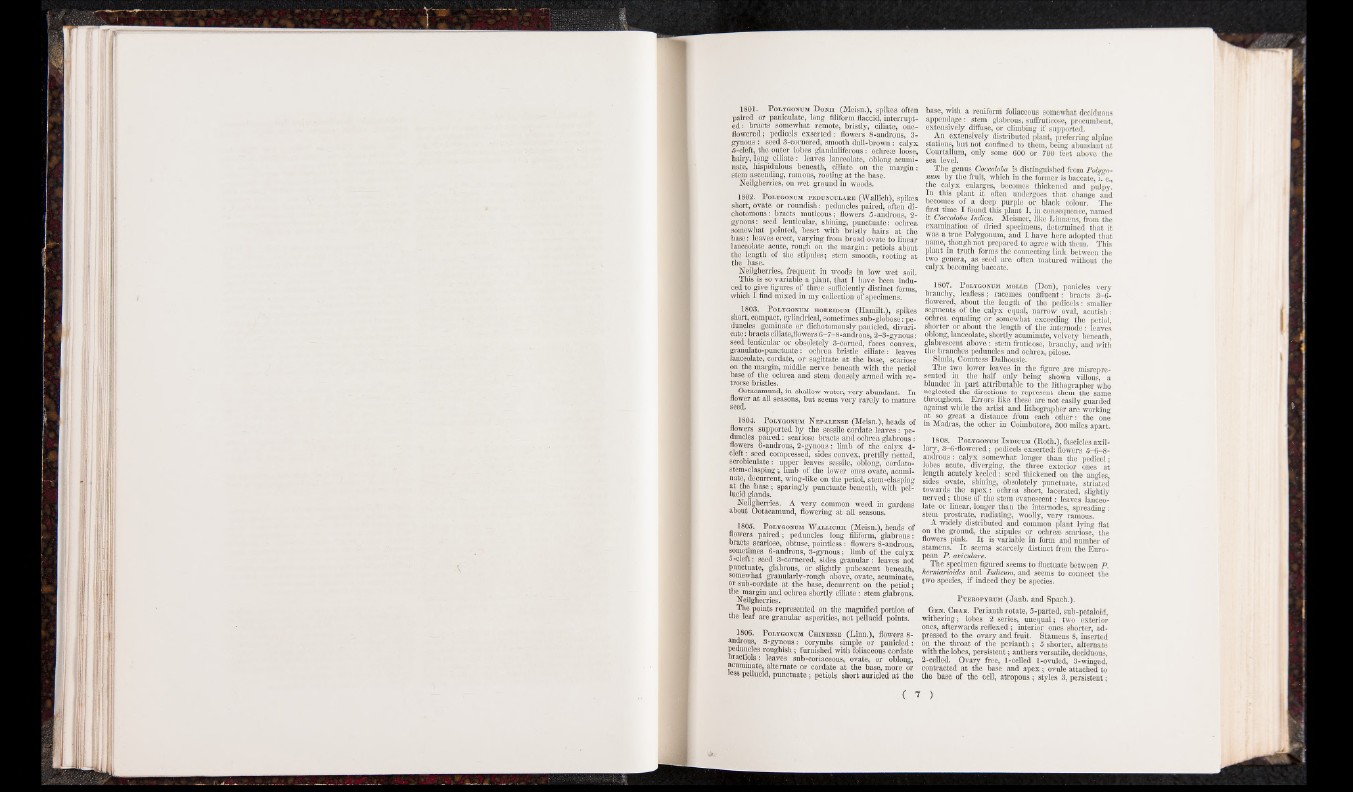
1801. P olygonum D onii (Meisn.), spikes often
paired or paniculate, long filiform flaccid, interrupted:
bracts somewhat remote, bristly, ciliate, one-
flowered; pedicels exserted: flowers 8-androus, 3-
gynous : seed 3-cornered, smooth dull-brown: calyx
5-cleft, the outer lobes glanduliferous : ochreas loose,
hairy, long ciliate: leaves lanceolate, oblong acuminate,
hispidulous beneath, ciliate on the margin:
stem ascending, ramous, rooting at the base.
Neilgherries, on wet ground in woods.
1802. P olygonum pedunculate (Wallich), spikes
short, ovate or roundish: peduncles paired, often dichotomous:
bracts muticous; flowers 5-androus, 2-
gynous: seed lenticular-, shining, punctuate: ochrea
somewhat pointed, beset with bristly hairs at the
base: leaves erect, varying from broad ovate to linear
lanceolate acute, rough on the margin: petiols about
the length of the stipules; stem smooth, rooting at
the base.
Neilgherries, frequent in woods in low wet soil.
This is so variable a plant, that I have been induced
to give figures of three sufficiently distinct forms,
which I find mixed in my collection of specimens.
1803. Polygonum horridum (Hamilt.), spikes
short, compact, cylindrical, sometimes sub-globose: peduncles
geminate or dichotomously panicled, divaricate
: bracts ciliate,flowers 6-7-8-androus, 2-3-gynous:
seed lenticular or obsoletely 3-comed, faces convex,
granulato-punctuate: ochrea bristle ciliate: leaves
lanceolate, cordate, or sagittate at the base, scariose
on the margin, middle nerve beneath with the petiol
base of the ochrea and stem densely armed with re-
trorse bristles.
Ootacamund, in shallow water, very abundant. In
flower a t all seasons, but seems very rarely to mature
seed.
1804. P olygonum N epalense (Meisn.), heads of
flowers supported by the sessile cordate leaves: peduncles
paired: scariose bracts and ochrea glabrous:
flowers 6-androus, 2-gynous: limb of the calyx 4-
cleft: seed compressed, sides convex, prettily netted,
scrobiculate: upper leaves sessile, oblong, cordato-
stem-clasping; limb of the lower ones ovate, acuminate,
decurrent, wing-like on the petiol, stem-clasping
at the base; sparingly punctuate beneath, with pellucid
glands.
Neilgherries. A very common weed in gardens
about Ootacamund, flowering at all seasons.
1805. Polygonum Wallichh (Meisn.), heads of
flowers paired; peduncles long filiform, glabrous:
bracts scariose, obtuse, pointless: flowers 8-androus,
sometimes 6-androus, 3-gynous; limb of the calyx
5-cleft: seed 3-cornered, sides granular: leaves not
punctuate, glabrous, or slightly pubescent beneath,
somewhat granularly-rough above, ovate, acuminate,
or sub-cordate at the base, decurrent on the petiol;
the margin and ochrea shortly ciliate: stem glabrous.
Neilgherries.
The points represented on the magnified portion of
the leaf are granular asperities, not pellucid points.
1806. Polygonum Chinense (Linn.), flowers 8-
androus, 3-gynous: corymbs simple or panicled:
peduncles roughish; furnished with foliaceous cordate
bractiols: leaves sub-coriaceous, ovate, or oblong,
acuminate, alternate or cordate at the base, more or
less pellucid, punctuate; petiols short auricled at the
base, with a reniform foliaceous somewhat deciduous
appendage: stem glabrous, sufiruticose, procumbent,
extensively diffuse, or climbing if supported.
An extensively distributed plant, preferring alpine
stations, but not confined to them, being abundant at
Courtallum, only some 600 or 700 feet above the
sea level.
The genus Coccoloba is distinguished from Polygonum
by the fruit, which in the former is baccate, i. e.,
the calyx enlarges, becomes thickened and pulpy.
In this plant it often undergoes that change and
becomes of a deep purple or black colour. The
first time I found this plant I, in consequence, named
it Coccoloba Indica. Meisner, like Linnaros, from the
examination of dried specimens, determined that it
was a true Polygonum, and I have here adopted that
name, though not prepared to agree with them. This
plant in truth forms the connecting link between the
two genera, as seed are often matured without the
calyx becoming baccate.
1807. P olygonum molle (Don), panicles very
branchy, leafless; racemes confluent: bracts 3-6-
flowered, about the length of the pedicels: smaller
segments of the calyx equal, narrow oval, acutish:
ochrea equaling or somewhat exceeding the petiol,
shorter or about the length of the internode : leaves
oblong, lanceolate, shortly acuminate, velvety beneath,
glabrescent above: stem fruticose, branchy, and with
the branches peduncles and ochrea, pilose.
Simla, Countess Dalhousie.
The two lower leaves in the figure are misrepresented
in the half only being shown villous, a
blunder in part attributable to the lithographer who
neglected the directions to represent them the same
throughout. Errors like these are not easily guarded
against while the artist and lithographer are working
at so great a distance from each other: the one
in Madras, the other in Coimbatore, 300 miles apart.
1808. P olygonum Indicum (Roth.), fascicles axillary,
3-6-flowered; pedicels exserted: flowers 5-6-8-
androus: calyx somewhat longer than the pedicel;
lobes acute, diverging, the three exterior ones at
length acutely keeled: seed thickened on the angles,
sides ovate, shining, obsoletely punctuate, striated
towards the apex: ochrea short, lacerated, slightly
nerved; those of the stem evanescent: leaves lanceolate
or linear, longer than the internodes, spreading:
stem prostrate, radiating, woolly, very ramous.
A widely distributed and common plant lying flat
on the ground, the stipules or ochrese scariose, the
flowers pink. I t is variable in form and number of
stamens. I t seems scarcely distinct from the European
P . aviculare.
The specimen figured seems to fluctuate between P.
hemiarioides and Indicum, and seems to connect the
two species, if indeed they be species.
Ptebopybum (Jaub. and Spach.).
Gen. Chab. Perianth rotate, 5-parted, sub-petaloid,
withering; lobes 2 series, unequal; two exterior
ones, afterwards reflexed; interior ones shorter, ad-
pressed to the ovary and fruit. Stamens 8, inserted
on the throat of the perianth; 5 shorter, alternate
with the lobes, persistent; anthers versatile, deciduous,
2-celled. Ovaiy free, 1-celled 1-ovuled, 3-winged,
contracted at the base and ap ex ; ovule attached to
the base of the cell, atropous; styles 3, persistent;